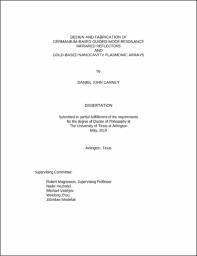
ATTENTION: The works hosted here are being migrated to a new repository that will consolidate resources, improve discoverability, and better show UTA's research impact on the global community. We will update authors as the migration progresses. Please see MavMatrix for more information.
Show simple item record
| dc.contributor.advisor | Magnusson, Robert | |
| dc.creator | Carney, Daniel John | |
| dc.date.accessioned | 2019-05-28T20:11:38Z | |
| dc.date.available | 2019-05-28T20:11:38Z | |
| dc.date.created | 2019-05 | |
| dc.date.issued | 2019-05-08 | |
| dc.date.submitted | May 2019 | |
| dc.identifier.uri | http://hdl.handle.net/10106/28097 | |
| dc.description.abstract | Design, fabrication, and measurement techniques for germanium-based guided-mode resonance infrared wideband reflectors and applications of guided-mode resonance devices for sensing and measurement applications are presented. Germanium is a versatile semiconductor with physical properties similar to silicon but optical properties that make it well suited for the infrared wavelengths. It has a high refractive index and negligible absorption in the mid to far infrared spectral region that can be used to create high field confinement necessary for wideband and high quality factor devices. Fabrication of germanium devices becomes straight-forward once the physical matters of germanium’s material bonding properties and surface chemistries are accounted for. Fabrication steps are presented for the deposition of thick germanium films using sputtering or electron beam evaporation methods, patterning the films using lithographic and nano-imprinting, and etching of these films to fabricate a guided-mode resonant or other photonic device. Designs are presented for four archetypal wideband longwave infrared guided-mode resonance reflectors, and the simplest design choice is fabricated as a proof of concept. Additional fabrication techniques are demonstrated with the device that involve depositing an additional conformal layer in order to refine its spectral response. Sputtered germanium films are found to have dynamic refractive index characteristics, and a study is carried out on their optical properties. The optical properties of sputtered germanium films are studied as they are found to vary from a 4% decrease to a 15% increase in their index of refraction over bulk crystalline material depending on the deposited layer thickness. Possible mechanisms driving this variance are discussed, and the refractive index of five separate films is measured and verified using a combination of Fabry-Perot transmission measurements and resonant measurements from guided-mode resonance devices patterned into the films. The material properties of the films are studied using energy-dispersive spectroscopy and x-ray diffraction spectroscopy and are found to indicate that no unexpected material compounds are present in the films that may be contributing to the refractive index shifts. Lastly, a chapter is included studying the resonant properties of plasmonic nano-cavity arrays. The resonant response of an array of gold nanocups is analyzed to discern its physical origin and found to be closely related to research governing the transmission of light through thin metallic films perforated with aperture arrays. The resonant response is determined to be a combination of the interaction of plasmonic modes with evanescent cavity modes within the array. | |
| dc.format.mimetype | application/pdf | |
| dc.language.iso | en_US | |
| dc.subject | Infrared | |
| dc.subject | Photonics | |
| dc.subject | Guided-mode resonance | |
| dc.subject | Plasmonics | |
| dc.subject | Nanofabrication | |
| dc.subject | Microfabrication | |
| dc.subject | Germanium | |
| dc.subject | Zinc sulfide | |
| dc.subject | Refractive index | |
| dc.title | DESIGN AND FABRICATION OF GERMANIUM-BASED GUIDED-MODE RESONANCE INFRARED REFLECTORS AND GOLD-BASED NANOCAVITY PLASMONIC ARRAYS | |
| dc.type | Thesis | |
| dc.degree.department | Electrical Engineering | |
| dc.degree.name | Doctor of Philosophy in Electrical Engineering | |
| dc.date.updated | 2019-05-28T20:13:47Z | |
| thesis.degree.department | Electrical Engineering | |
| thesis.degree.grantor | The University of Texas at Arlington | |
| thesis.degree.level | Doctoral | |
| thesis.degree.name | Doctor of Philosophy in Electrical Engineering | |
| dc.type.material | text | |
Files in this item
- Name:
- CARNEY-DISSERTATION-2019.pdf
- Size:
- 6.333Mb
- Format:
- PDF
This item appears in the following Collection(s)
Show simple item record


